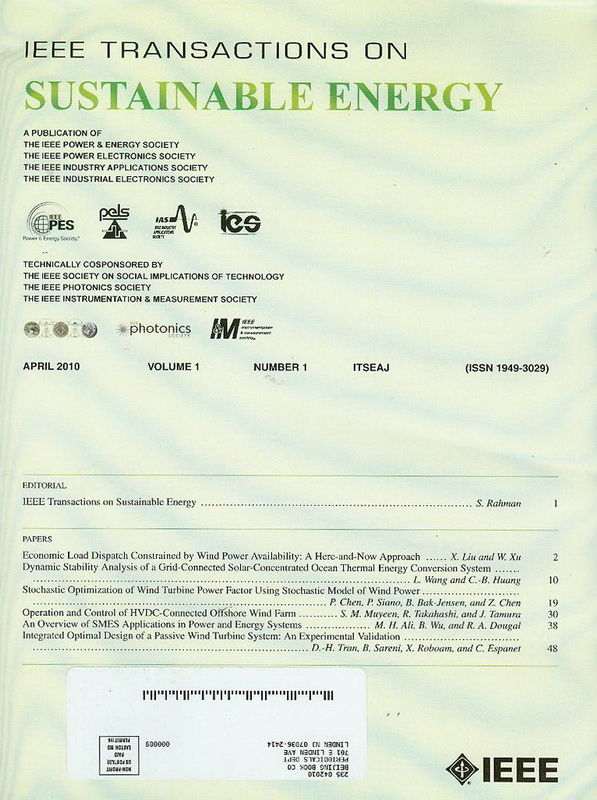Contribution of PV Generation With Embedded Battery Storage to Capacity Adequacy
IF 10
1区 工程技术
Q1 ENERGY & FUELS
引用次数: 0
Abstract
This paper proposes a real-time redispatch method for including PV-plus-battery plants in resource adequacy assessment (RAA) studies. The method offers the possibility to represent the market operation of the assets, while at the same time considering their response to reliability events, unlike existing methods in the literature that manage such assets in a single-dimensional manner, driven solely by adequacy contribution considerations or entirely ignoring this capability. In the proposed method, while the plant is initially dispatched in a market-oriented manner, i.e., with the objective of maximizing market revenues, its actual operation is adapted to meet system needs when reliability events take place. The method is incorporated into a Monte Carlo (MC) based RAA model in a computationally efficient manner, relying on a deterministic implementation of redispatching that does not impact significantly the computational burden of the RAA model, thus enabling the execution of multiple MC samples to achieve a high stochastic process accuracy. A merit order algorithm is also embedded into the RAA model to evaluate the PV-plus-battery market revenues. The model developed allows a refined calculation of the capacity value (CV) of such assets for different plant configurations and inverter loading ratios, while the upper and lower CV bounds are approximated via application of the adequacy- and market-oriented approaches available in the literature. Results show that the embedded storage energy capacity is crucial for the CV afforded by the assets, while any decrease in the inverter capacity does not significantly impact the CV value. Further, the CV of storage embedded in tightly coupled PV-plus-battery plants, where batteries are exclusively charged by the plant's own PV generation, is generally lower than the value of similar stand-alone storages operating without any charging constraints.嵌入式电池储能对光伏发电容量充足性的贡献
本文提出了一种将光伏+电池电站纳入资源充分性评估(RAA)研究的实时再调度方法。该方法提供了代表资产市场运作的可能性,同时考虑了它们对可靠性事件的响应,不像文献中的现有方法以单一的方式管理此类资产,仅由充分性贡献考虑驱动或完全忽略这种能力。在本文提出的方法中,初始调度以市场为导向,即以市场收益最大化为目标,但在可靠性事件发生时,调整其实际运行以满足系统需求。该方法以计算效率高的方式纳入基于蒙特卡罗(MC)的RAA模型,依靠确定性的重新调度实现,不会显著影响RAA模型的计算负担,从而使多个MC样本的执行能够达到较高的随机过程精度。在RAA模型中还嵌入了价值排序算法,以评估光伏+电池的市场收入。所开发的模型允许对不同工厂配置和逆变器负载比的此类资产的容量值(CV)进行精确计算,而CV上限和下限是通过应用文献中可用的充分性和市场导向方法来近似的。结果表明,嵌入式储能容量对资产提供的CV值至关重要,而逆变器容量的任何降低都不会显著影响CV值。此外,在紧密耦合的光伏+电池工厂中,电池完全由工厂自己的光伏发电充电,存储的CV通常低于没有任何充电限制的类似独立存储的值。
本文章由计算机程序翻译,如有差异,请以英文原文为准。
求助全文
约1分钟内获得全文
求助全文
来源期刊

IEEE Transactions on Sustainable Energy
ENERGY & FUELS-ENGINEERING, ELECTRICAL & ELECTRONIC
CiteScore
21.40
自引率
5.70%
发文量
215
审稿时长
5 months
期刊介绍:
The IEEE Transactions on Sustainable Energy serves as a pivotal platform for sharing groundbreaking research findings on sustainable energy systems, with a focus on their seamless integration into power transmission and/or distribution grids. The journal showcases original research spanning the design, implementation, grid-integration, and control of sustainable energy technologies and systems. Additionally, the Transactions warmly welcomes manuscripts addressing the design, implementation, and evaluation of power systems influenced by sustainable energy systems and devices.
 求助内容:
求助内容: 应助结果提醒方式:
应助结果提醒方式:


